[Retracted] Research on Teaching Quality Evaluation of Ideological Politics Teachers in Colleges and Universities Based on a Structural Equation Model
Abstract
With the dawn of a new era, ideological politics education plays an increasingly high role in college education, so the responsibilities given to ideological politics teachers in universities are increasing. The traditional teaching quality estimate model lags behind in accuracy, precision, and recall rate. Therefore, aiming at this phenomenon, this paper puts forward a teaching quality evaluation model for ideological politics teachers in universities based on the structural equation model. The purpose is to improve the estimated test time and improve the evaluation accuracy and accuracy. The research results of the article show the following: (1) The comparison results of the four models show that the estimate results of the model constructed in this paper have the highest accuracy, accuracy, and recall, with an average accuracy of 98.49%, an average accuracy of 98.31%, and an average recall rate of 98.28%. (2) After testing, the structural equation model takes the least time, with an average test time of 9.4 ms, which is far lower than the test time of the other three models. (3) According to the statistics of the weight of each index, among the first-class indexes, the weight of teachers’ self-evaluation is the lowest, and the weight of students’ evaluation is the highest, accounting for 0.625. The weights of the middle class, teaching implementation, and teaching and educating people in the secondary indicators are all above 0.5, and most of the rest are between 0.2 and 0.4. (4) For the formal estimate of teachers’ teaching quality, the results show that the scores of the test subjects are above 90 points, the highest score is 99, and the average score is 94.5, which meets the test standard. (5) Finally, the model is evaluated, and it is concluded that each score is above 4.5, the highest score is 4.9, and the average score is 4.7, indicating that the model meets the standards and is highly recognized in people’s hearts.
1. Introduction
Ideological politics education is in the stage of rapid development, so it is necessary to establish a scientific and reasonable estimate system of teaching quality. Ideological politics education is a particularly important subject in the current social development. The responsibility of ideological and political teachers is self-evident. Therefore, we should pay attention to improving the teaching quality of ideological and political teachers. Structural equation modeling is a reliable and flexible statistical method [1] and has a high value, especially for evaluation research. Now, it has become a popular method [2], used to estimate complex models with potential variables and their relationships. Evaluation researchers are increasingly interested in structural equation model technology [3]. The structural equation model is of great significance in evaluation research [4]. The advantage of this method is that the analysis can be replicated according to the matrix and information specific to the model [5]. This model describes one of the most prominent research methods across multiple disciplines [6]. The structural equation model is a comprehensive statistical method [7]. It is mainly used to test hypotheses about the relationship between observed variables and potential variables. Structural equation modeling now uses the maximum likelihood method to deal with missing data [8]. This is a technology widely used in instrument verification and model testing [9]. We use this method to evaluate the teaching quality of teachers [10]. On the basis of teaching quality management in colleges and universities, the evaluation model of teaching quality is constructed by using the analytic hierarchy process [11]. The evaluation of education quality needs to go through the stages of task determination, standard proposal, development, and exploration [12]. To construct the quality evaluation system of ideological politics education in colleges and universities, we must adhere to the leadership of the Party, seek quality orientation in moral education, and pay attention to the internal and external coordination of ideological and political education quality. For the sake of improving teachers’ teaching quality, we can implement the evaluation method of teachers’ teaching quality [13]. The model takes student evaluation as the main body [14]. It is helpful to master teachers’ teaching situations and improve teaching quality. The evaluation of teachers’ teaching quality is the judgment of teachers’ values [15].
2. Theoretical Basis
2.1. Structural Equation Model
2.1.1. Introduction to Structural Equation Modeling
The structural equation model (SEM) is also called a causality model [16]. In the 1870s, Swiss scholars put forward this method by combining the measurement characteristics of factor analysis with the regression modeling characteristics of path analysis.
2.1.2. Structural Equation Model Expression
2.2. Maximum Likelihood Estimation Method
Maximum likelihood estimation (MLE) is the most commonly used means in structural equation modeling [17].
2.2.1. Discrete Type
Then L(θ) is the likelihood function of the sample.
2.2.2. Continuous Type
is called the maximum likelihood estimator of θ.
2.3. Covariance Matrix
A structural equation model is a statistical method to analyze the relationship between variables based on the covariance matrix of variables [20].
2.3.1. Concept
2.3.2. Properties
2.3.3. Application
2.4. Evaluation of Teachers’ Teaching Quality
2.4.1. The Purpose of Teacher Teaching Quality Evaluation
The purpose of the teachers’ teaching quality estimate is to test the results of teachers’ “teaching” and students’ “learning” [21].
2.4.2. Principles of Teacher Teaching Quality Evaluation
The principles of teachers’ teaching quality estimate include objectivity, systematicness, measurability, and orientation [22], as shown in Table 1.
| Principle | Content |
|---|---|
| Objectivity principle | The teaching quality estimate is aimed at measuring, analyzing, and evaluating the effectiveness of teachers’ teaching work. Its evaluation standards, evaluation methods, and attitudes of evaluation subjects must be objective to ensure the authenticity of evaluation results. |
| Systemic principle | Teachers’ teaching quality is influenced by many factors such as teaching attitude, teaching methods, and teaching means. For the sake of reflecting the real teaching effect, teachers’ teaching quality evaluation must comprehensively consider various influencing factors and adopt qualitative and quantitative methods to comprehensively evaluate. |
| Testability principle | Evaluation indicators must be measurable, so that the evaluation subject can quickly and accurately make judgments according to the evaluation indicators. |
| Guiding principle | The evaluation results should be inspiring and guiding and should point out the future direction for the evaluators. |
2.4.3. Evaluation Methods of Teaching Quality
The evaluation methods of teaching quality mainly include qualitative evaluation and quantitative evaluation: qualitative evaluation refers to the value judgment of the evaluated person, which is to draw a qualitative conclusion according to the specific performance of the evaluation subject to the evaluated person in all aspects. Quantitative evaluation means that the value judgment of the evaluator is the use of mathematical methods to evaluate the specific performance of the evaluator in various aspects to draw a conclusion.
2.5. Ideological and Political Education
Ideological politics education is mainly to integrate ideological politics education into the classroom and explain its basic theory, ideological values, and spiritual pursuit that contemporary youth should have. As the successors of the Party and the country, we should have correct political thoughts and walk on the correct ideological politics road.
In a sense, ideological politics education is to improve our ideological pursuit, enrich our spiritual thoughts, let us have correct life values, and make powerful contributions to the party and the country.
3. Model Building
3.1. The Modeling Procedure of Structural Equation Model
The modeling steps of the structural equation model are divided into modeling, model recognition, fitting, evaluation, and modification [23], as shown in Table 2.
| Step | Content |
|---|---|
| Model building | To establish the model, we must first fully understand the development of research content and establish the model on the basis of the correct theory. It should be fully aware of the various relationships between emerging variables and identify potential variables and observed variables and their relationships. |
| Model identification | Model identification is to judge whether the structural equation model can run and fit successfully after introducing data. There are three types of recognition: unrecognized, just recognized, and overrecognized. |
| Model fit | Model fitting is to import the collected data into the Amos software for parameter estimation. Firstly, the measurement model is estimated and tested by confirmatory factor molecules, and then the structural model is estimated and tested by path analysis. |
| Model evaluation | Model evaluation refers to judging whether the index value of the output results meets the preset fitness standard of the model after the establishment of the structural equation model, including the absolute adaptation criteria and relative adaptation criteria of the model. |
| Model correction | After model fitting, if the fitting index reflects that the model fitting is not good, it needs to be adjusted by model modification. Model revision should be cautious. It is necessary to add or delete variables according to the fitting index and adjust the path or parameters to achieve the best fitting degree. |
p + q is the number of observed variables.
The evaluation procedure of the structural equation model is shown in Figure 1.

3.2. Construction of Teacher Teaching Quality Evaluation System
The appraisal system of teachers’ teaching quality mainly consists of teachers’ self-appraisal, students’ appraisal, peer appraisal, supervision appraisal, and leadership appraisal [24], as shown in Table 3.
| System | Appraisal content and method |
|---|---|
| Teacher self-assessment | Teachers evaluate teaching from three respects: before, during, and after class. |
| Student evaluation | Students can evaluate teachers’ teaching quality from three aspects: classroom performance, classroom teaching, and curriculum effectiveness. |
| Peer review | Peer teachers evaluate teachers’ teaching quality from three aspects: teaching design, teaching implementation, and teaching reform by checking the teaching plan, listening to lectures, and participating in teaching and research activities. |
| Supervisory evaluation | Teaching supervision evaluates teachers’ teaching quality from four aspects: teaching approach, teaching substance, teaching means and methods, and teaching effect by means of patrolling and listening to classes. |
| Leadership evaluation | Leaders evaluate teachers’ teaching quality from three aspects: teaching preparation, teaching process, and teaching and educating people through teaching plan inspection and lectures. |
The evaluation system of teachers’ teaching quality is shown in Figure 2.

3.3. Evaluation Index of Teaching Quality
According to the analytic hierarchy process, a five-dimensional analysis model of the teaching quality of ideological politics teachers in universities is constructed, and the Tertiary Index is established. The Primary Index includes teacher self-appraisal, student appraisal, peer appraisal, supervisory appraisal, and leadership appraisal; the Secondary Index includes 16 before, during, and after class; the Tertiary Index includes 50 such as “seriously correcting homework, patiently tutoring, and answering questions” and “conscientious attitude and decent behavior.”
By comparing the importance of the Secondary Index to the Primary Index and the importance of the Tertiary Index to the indicators, the weights of the Secondary Index and the Tertiary Index can be obtained. The index system is shown in Table 4.
| Main target | Primary index | Secondary index | Tertiary index |
|---|---|---|---|
| Teacher’s teaching quality | Teacher self-assessment | Before class | Dedicated, hardworking, and passionate about teaching |
| Well prepared before class | |||
| In class | The teaching content is rich and informative | ||
| Introduce cases and link theory with practice | |||
| Explain the regulations clearly, highlighting the important and difficult points | |||
| Integrate the ideological politics elements of the course | |||
| Can effectively adjust the classroom atmosphere | |||
| Students acquire knowledge and skills | |||
| After class | Carefully correct homework, patiently guide, and answer questions | ||
| Diagnose and improve classroom teaching actively | |||
| Student evaluation | Classroom performance | Serious attitude and good manners | |
| Full of energy, strong affinity | |||
| The language is vivid and stimulates students’ curiosity | |||
| Classroom teaching | Rich teaching resources | ||
| Advanced teaching methods and flexible methods | |||
| Linking theory with practice, appropriate cases | |||
| Respect for students, harmonious relationship between teachers and students | |||
| Be able to answer questions for students carefully and patiently | |||
| Classroom effectiveness | Mastered the basic knowledge and basic skills | ||
| Broadened horizons | |||
| Peer review | Instructional design | Teaching goals are clearly defined | |
| Accurately grasp the key points and difficulties of teaching | |||
| Appropriate use of teaching methods and means | |||
| Attach importance to the cultivation of students’ innovative practical ability | |||
| Teaching implementation | Rigorous and serious academic attitude | ||
| Lectures are refined, vivid, and accurate | |||
| Emphasis on teacher-student communication, active atmosphere | |||
| Students acquire knowledge and skills | |||
| Teaching reform | Actively carry out research on teaching reform | ||
| Continuously improve teaching and improve quality | |||
| Supervisory evaluation | Teaching attitude | Prepare carefully and prepare well | |
| Full of energy and passion | |||
| Teaching content | Proficient in content and a large amount of information | ||
| Difficulties are highlighted, and the structure is clear | |||
| The explanation is refined and vivid | |||
| The organic integration of “ideological politics education” and teaching | |||
| Teaching methods and means | Advanced methods and flexible teaching methods | ||
| The relationship between teachers and students is harmonious, and the atmosphere is active | |||
| Teaching effect | A high degree of achievement of teaching objectives | ||
| Arouse students’ curiosity | |||
| Leadership evaluation | Teaching preparation | Careful preparation of lessons, full of content | |
| Rich teaching resources such as videos and courseware | |||
| Teaching process | Rigorous attitude, dignified appearance | ||
| Full of energy, strong affinity | |||
| Accurate lectures, highlighting important and difficult points | |||
| Regulation cleaning, explain in simple language | |||
| Flexible teaching methods and advanced methods | |||
| Teaching and educating people | Students acquire basic knowledge and skills | ||
| Reflect “Lide Shuren” | |||
| Students’ interest is nurtured and stimulated |
3.4. AHP
AHP is a qualitative evaluation means [25]. The procedure of the AHP is divided into the construction of the evaluation index model, the construction of the judgment matrix, the determination of index weight, and the consistency test.
4. Experimental Analysis
4.1. Model Checking
In order to see the test results of this model more intuitively, this experiment will select traditional evaluation models, deep learning models, and big data models for comparative analysis. We will randomly select 100 ideological and political students from a university, 10 people will form a group, and a total of 10 groups will be tested. The test sample is students’ evaluation of the teaching quality of ideological politics teachers.
4.1.1. Accuracy Comparison
First of all, the accuracy of the model will be tested so as to test the correctness of the model when evaluating the teaching quality of ideological politics teachers in the university. It is shown in Figure 3.
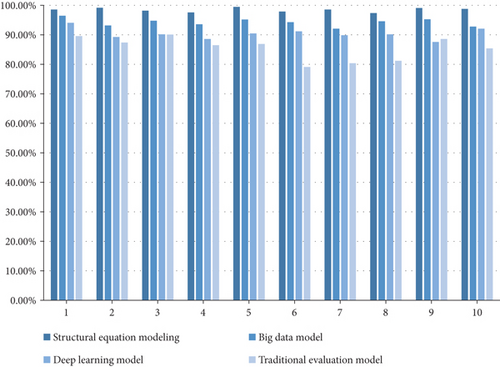
From Figure 3, we can see that the model constructed in the text has the highest evaluation precision, with an average evaluation precision of 98.49%. Compared to the other three models, this model is 4.25% higher than the big data model, 8.12% higher than the deep learning model, and 12.97% higher than the traditional evaluation model. Therefore, this model has higher accuracy and superiority.
4.1.2. Accuracy Comparison
Accuracy means that the error of the test result is within the specified range. By comparing the accuracy of the four models, we can know the superiority of the model. It is shown in Figure 4.
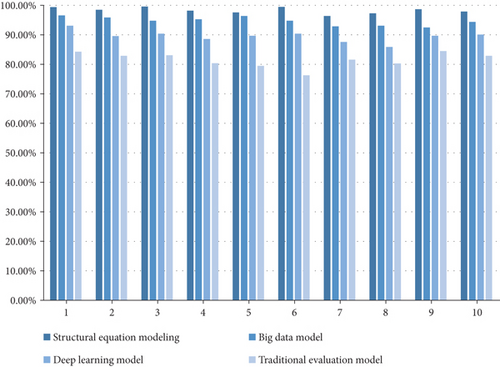
It can be seen from Figure 4 that the structural equation model has the highest accuracy, with an average accuracy rate of 98.31%. Compared with the other three models, it is 3.64% higher than the big data model, 8.8% higher than the deep learning model, and 16.73% higher than the traditional evaluation model.
4.1.3. Comparison of Recall Rates
Recall refers to the rate of correct predictions in a sample. The recall comparing results of the four models are shown in Figure 5.
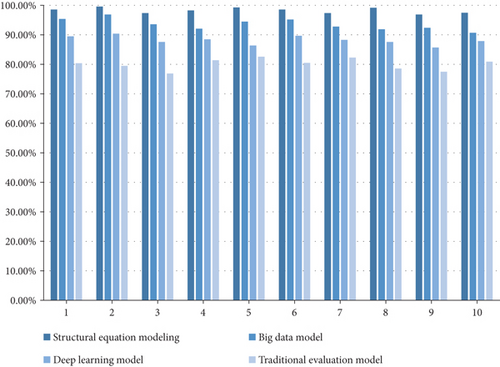
It can be seen from Figure 5 that the recall rate of the structural equation model is the highest, the highest value is 99.6%, and the average recall rate is 98.28%. Compared with the other three models, it is 4.73% higher than the big data model, 10.12% higher than the deep learning model, and 18.22% higher than the traditional evaluation model, so this model is better.
4.1.4. Test Time Comparison
The four models were tested 10 times, and the time spent on their tests was recorded. The results showed that the structural equation model took the least time, with an average test time of 9.4 ms, which was much lower than the test time of the other three models. It is shown in Figure 6.
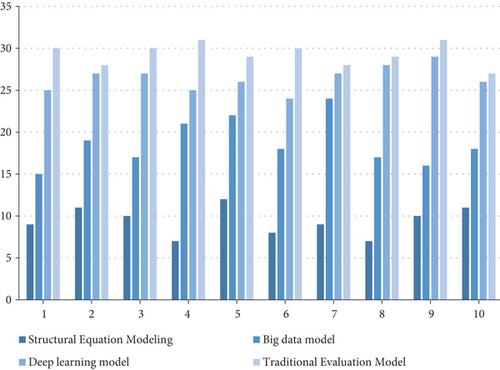
According to the results, we conclude that the structural equation model test takes the least time, which can greatly reduce the research time of teaching quality estimate and improve the work efficiency.
4.2. Indicator Weights
For the evaluation research of political science teachers’ teaching quality in universities, it is necessary to determine the weight coefficient of each index, so as to be more accurate in the evaluation of teaching quality.
4.2.1. Primary Indicators
The weight coefficients of five first-level indicators can be obtained by calculation.
The specific weights of the first-level indicators are shown in Figure 7.
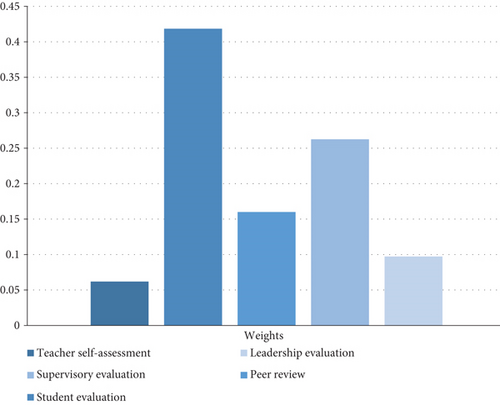
4.2.2. Secondary Indicators
The specific weights of the secondary indicators are shown in Figure 8.
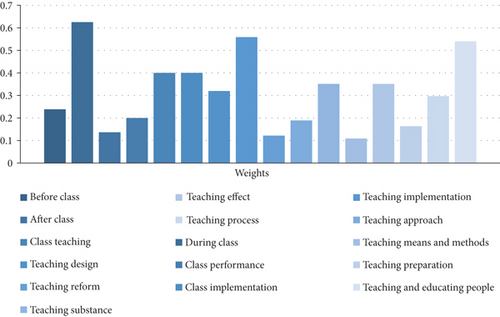
From Figure 7, we can see that the weight of teacher self-evaluation is the lowest, and the weight of student evaluation is the highest, accounting for 0.625. The weight of each indicator is different, which means that each indicator has different standards and focuses on the evaluation of ideological politics and teachers’ teaching quality. Some indicators are important, and some indicators are relatively unimportant and are only used as a reference. According to Figure 8, we can know that the weights of class, teaching implementation, and teaching and educating people are all above 0.5, and the rest are between 0.2 and 0.4.
4.3. Evaluation of Teaching Quality
This experiment will evaluate an ideological politics teacher in a university. The experiment will use the model designed in this article to estimate the teaching quality of ideological politics teachers in universities according to the indicators mentioned above. Taking the secondary index as the evaluation standard, the results are shown in Figure 9.
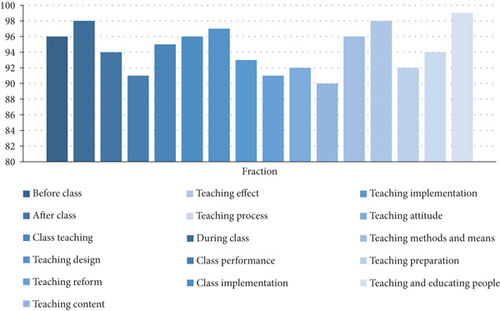
According to the results in Figure 9, the scores of each evaluation index are above 90, the highest score is 99, and the average score is 94.5. This model test can effectively reflect teachers’ teaching problems, and teachers can find out their own teaching deficiencies in time and then make corrections.
4.4. Model Evaluation
For the sake of proving the practicability of the model, we asked the reviewers mentioned in the first-level index to score the model, with a total score of 5 points, and the average score above 4.5 indicates that the model has a high recognition among teaching system personnel. The scoring situation is shown in Figure 10.
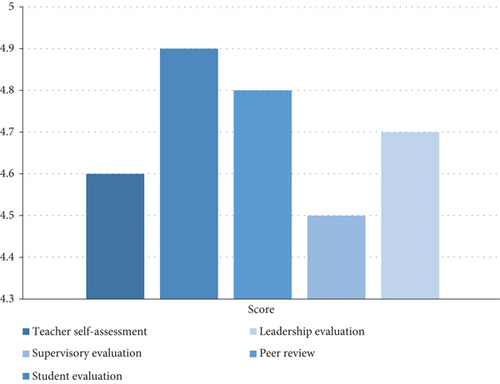
As can be seen from Figure 10, the scores of each reviewer are above 4.5, the highest score is 4.9, and the average score is 4.7, indicating that the model meets the standard.
5. Conclusion
The new era gives us college students more responsibilities, and ideological politics education is one of the ways to perfect our ideological height. The traditional evaluation model has a certain lag, so this paper designs a new model to improve this problem. The evaluation model of teaching quality of ideological politics teachers in high school based on the structural equation model designed in this paper improves the correctness, precision, and recall on the basis of the traditional evaluation model and shortens the test time. It helps reviewers improve their work efficiency and is of great significance in the research of evaluating teaching quality.
The findings of the article show that
(1) The comparison results of the four models show that the evaluation results of the model constructed in this paper have the highest accuracy, accuracy, and recall rate, with an average accuracy of 98.49%, an average accuracy of 98.31%, and an average recall rate of 98.28%
(2) After testing, the structural equation model takes the least time, with an average test time of 9.4 ms, which is far lower than the test time of the other three models
(3) In the first-level indicators, the weight of teachers’ self-evaluation is the lowest, and the weight of students’ evaluation is the highest, accounting for 0.625. The weights of the middle class, teaching implementation, and teaching and educating people in the secondary indicators are all above 0.5, and most of the rest are between 0.2 and 0.4
(4) For the formal estimate of teachers’ teaching quality, results show that the scores of the test subjects are above 90 points, the highest score is 99, and the average score is 94.5, which meets the test standard
(5) Finally, the model is evaluated, and it is concluded that each score is above 4.5, the highest score is 4.9, and the average score is 4.7, indicating that the model meets the standards and is highly recognized in people’s hearts
Although the method studied in this article has obvious advantages, it still has certain limitations. The method is limited to the appraisal of the teaching quality of ideological politics teachers, and the research scope is small. The limitations and uncertainties of the model studied in this paper need to be further improved in the following experiments to increase its universality and make the entire evaluation system more complete.
Conflicts of Interest
The authors declared that they have no conflicts of interest regarding this work.
Acknowledgments
This work was supported by the 2021 Philosophy and Social Science Program of Hainan Province (Ideological and Political Project): Research on the Way of Hainan Red Culture Integrating into Ideological and Political Course in Hainan Universities, China (Grant No. hnsz2021-40).
Open Research
Data Availability
The experimental data used to support the findings of this study are available from the corresponding authors upon request.




